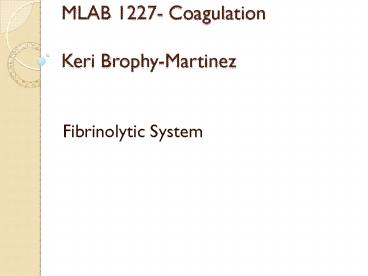MLAB 1227- Coagulation Keri Brophy-Martinez - PowerPoint PPT Presentation
1 / 17
Title:
MLAB 1227- Coagulation Keri Brophy-Martinez
Description:
MLAB 1227- Coagulation Keri Brophy-Martinez Fibrinolytic System * * * * * * * Fibrinolysis Process of removing fibrin from the vasculature Key Players Plasminogen ... – PowerPoint PPT presentation
Number of Views:200
Avg rating:3.0/5.0
Title: MLAB 1227- Coagulation Keri Brophy-Martinez
1
MLAB 1227- CoagulationKeri Brophy-Martinez
- Fibrinolytic System
2
Fibrinolysis
- Process of removing fibrin from the vasculature
- Key Players
- Plasminogen
- Plasminogen activators (PA)
- Active enzyme plasmin (PLN)
- Fibrin
- Fibrin/Fibrinogen degradation products
- Inhibitors of plasminogen activators and PLN
3
Fibrinolytic System
- Sensitive to imbalances
- Restricts fibrin formation to area of injury
- Initiated when coagulation cascade begins
- Dissolves clot by digestion of fibrin
4
Overview
- Under the influence of thrombin.
- Fibrinogen cleaved into fibrin monomers
- Fibrin monomers are cleaved into fibrin
degradation products or fibrin split products
5
Process summary
- Once clotting begins, the fibrinolytic system
comes to life - Plasminogen (PLG) binds to fibrin in the
developing thrombus - Tissue-type PLG activator (tPA) also binds to
fibrin, increasing its enzymatic activity to
convert plasminogen to plasmin (PLN) - Complex formation of tPA, PLG and fibrin results
in the break-down of fibrin - PLN then further digest fibrin to soluble
degradation products making fibrin fragments
6
Plasminogen
- Produced in the liver
- Found in normal plasma
- Following injury, binds to fibrin during clot
formation along with plasminogen activators
7
Activators of Fibrinolysis
- Contact Phase/Intrinsic
- Occurs by interactions of the contact factors
(XIIa, HMWK, and PK) following intrinsic pathway
activation(collagen exposure) - Physiologic
- Activators released from tissues extrinsic to the
blood - tPA tissue- type PLG activator
- Found in endothelial cells of small vessels
- uPA urokinase-type PLG activator
- Made in renal tubular epithelium and vascular
epithelium - Found in urine and plasma
- Exogenous activation
- Via medications given to lyse pathogenic clots
(i.e. pulmonary emboli) - Example includes Streptokinase
8
Activators
9
Plasmin
- Proteolytic enzyme
- Dissolves fibrin/fibrinogen clots into protein
fragments that are cleared from plasma by the
liver - Provides a positive feedback loop for forming
more plasminogen - Highly regulated
- Temporarily active
- Local
10
Fibrinogen and Fibrin
- Fibrin degradation products are the protein
fragments of fibrin or fibrinogen. - The protein fragments are designated X, Y, D, and
E - Fragments are strong inhibitors of further
coagulation by - interfering with the action of thrombin
- interfering with platelet aggregation
- In the lab, referred to as FDPs or FSPs
- Fibrin degradation products are cleared by the
liver - Fibrinogen and fibrin yield essentially the same
fragments however degradation of cross-linked
fibrin is slower and leads to fragments that
contain D-dimer.
11
Plasmin Degradation of Fibrinogen
E
Fibrinogen
D
D
plasmin
E
D
D
Fragment X small peptides from carboxyl end of a
chain removed
plasmin
E
Fragment Y Fragment D
D
D
plasmin
E
D
Fragment D Fragment E
12
- Plasminogen
- Intrinsic/contact activation
Physiologic activation -
Exogenous activation - Plasmin
- Fibrin clot Fibrinogen
- Fibrin
- Degradation Fibrinogen
- Products Degradation
- Products
- X,Y,DD,E X,Y,D,E,D
13
Inhibitors of Fibrinolysis
- Used to regulate and limit plasmin activity and
fibrinolysis - Also referred to as an antiplasmin
- How?
- Target PLG activation step
- Target plasmin
14
Inhibitors of Fibrinolysis
Inhibitors
Inhibitors
15
Specific Inhibitors
- Plasminogen Activator Inhibitor (PAI)
- PAI-1 most significant
- Inhibits tPA and uPA
- Acute phase reactant protein
- Thrombin Activatable Fibrinolysis Inhibitor
(TAFI) - Eliminates fibrin binding sites for plasminogen
16
Specific Inhibitors
- alpha-2-antiplasmin
- Rapid inhibitor of plasmin
- Functions to catch leaked PLN in the
circulation, thus limiting activity to fibrin
clot - Produced in liver and a granules in platelets
- alpha-2-macroglobulin
- Slower inhibitor of plasmin
17
References
- McKenzie, Shirlyn B., and J. Lynne. Williams.
"Chapter 30." Clinical Laboratory Hematology.
Boston Pearson, 2010. Print.































